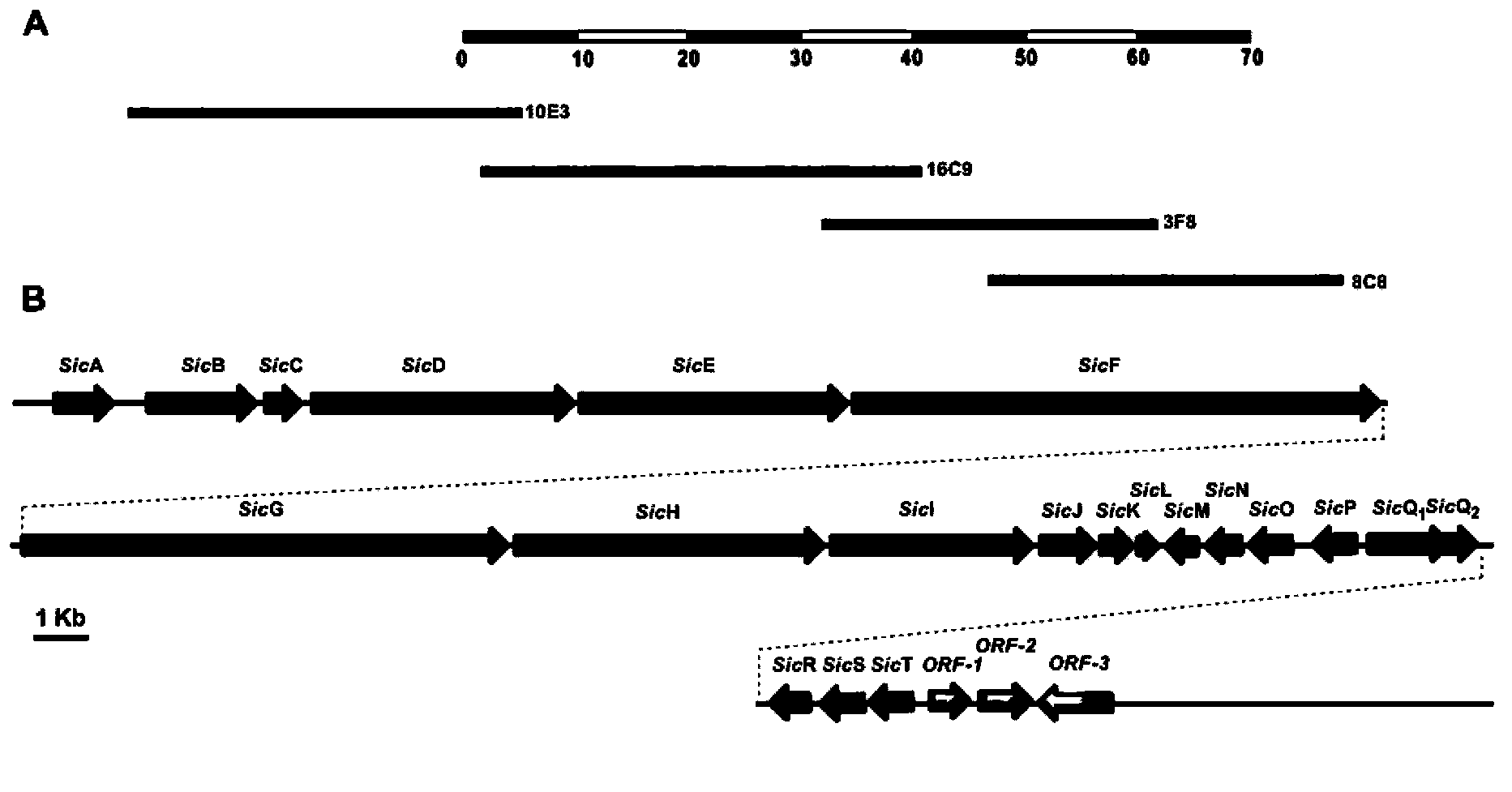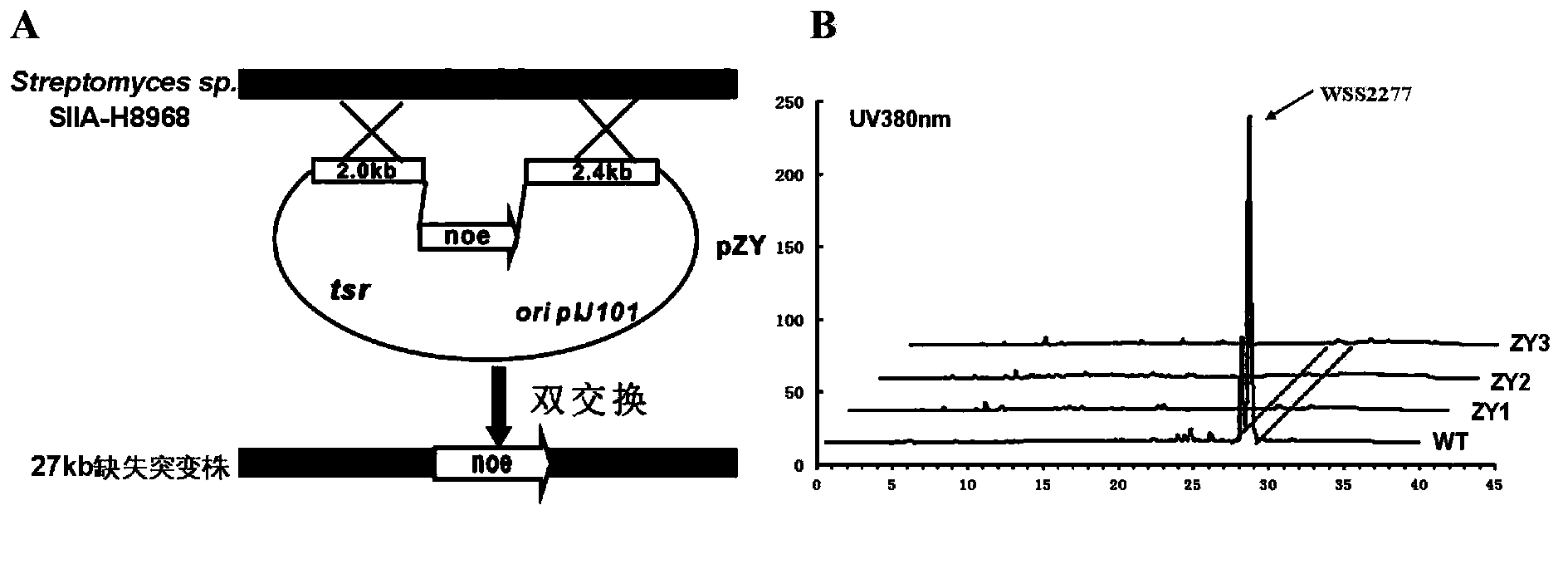Biosynthesis gene cluster of polyenoid and polyol macrolide compound
A technology for biosynthesis and compound application in the field of biomedicine, which can solve the problems of unclear mechanism of action and no antifungal activity.
- Summary
- Abstract
- Description
- Claims
- Application Information
AI Technical Summary
Problems solved by technology
Method used
Image
Examples
Embodiment 1
[0062] Example 1 Extraction of WSS2277-producing strain Streptomyces sp. SIIA-H8968 genomic DNA:
[0063]Inoculate 20 μl of 20% glycerol-preserved Streptomyces sp. SIIA-H8968 spores into 10 ml of seed medium (TSB medium, Oxoid Company), culture on a shaker at 30°C for 20 hours, and centrifuge to collect the bacteria for later use. Resuspend 50 mg mycelia in 500 μl lysozyme solution and incubate at 37°C for about 30 min, or until the cells become translucent. Add 100 μl 10% SDS, mix and shake for about 1 min until the viscosity of the solution drops significantly, incubate at 37°C for 20 min, then add 250 μl neutral phenol / chloroform, mix and shake evenly, centrifuge at 12000 r / min for 5 min, pipette Supernatant, discard the white intermediate layer. Repeat the second extraction with neutral phenol / chloroform until the middle layer is invisible (or very little), and finally add 0.1 volume of 3 M sodium acetate (pH natural), mix and add 1 volume of isopropanol (or 2.2 times th...
Embodiment 2
[0064] Example 2 Construction and screening of the genome library of Streptomyces sp. SIIA-H8968, which produces WSS2277:
[0065] The construction method of the genomic library refers to the experimental method provided by the kit CopyControl? Fosmid Library Production Kit.
[0066] A pair of polymerase chain reaction (PCR) primers (5'-GAGGACCCGGTCWCSTWCGCSGTSAAC-3 ') and (5'-AGCAGCCSGASCCGTASGAGAA -3') successfully amplified a specific product of the expected size from WSS2277-producing strain Streptomyces sp. SIIA-H8968, and sequence analysis showed that the amino acid sequence homology between the two was 70%. Based on this primer, the polymerase chain reaction (PCR) is used to screen the genomic library. First, the clones of each 96-well plate are mixed and cultured, and the mixed cosmid is used as a template, and then the PCR reaction is carried out. The positive signal is located in each For 96-well plates, the same method is followed by positioning in rows and finally...
Embodiment 3
[0067] Example 3 Establishment of WSS2277-producing bacteria Streptomyces sp. SIIA-H8968 conjugative transfer system:
[0068] Fresh spores of Streptomyces sp. SIIA-H8968 grown in SFM medium were collected for use. The oriT-containing target plasmid must be assisted by the helper plasmid pUZ8002 to be introduced into recipient Streptomyces cells by conjugative transfer. First, transform the plasmid to be transferred into Streptomyces sp. SIIA-H8968 into Escherichia coli ET12567 / pUZ8002, then culture the Escherichia coli ET12567 / pUZ8002 containing the target plasmid, collect the cells after 4 hours, and wash the cells twice with fresh LB medium spare. Streptomyces spores used as recipients need to be heat-shocked and pre-germinated. Streptomyces spores were resuspended in 5 ml of 0.05 M TES buffer at pH 8.0, heat-shocked in a water bath at 50°C for 10 min, cooled to room temperature, and then added with an equal volume of 2× spore pre-germination medium (Oxoid yeast extract 1...
PUM
 Login to View More
Login to View More Abstract
Description
Claims
Application Information
 Login to View More
Login to View More - R&D
- Intellectual Property
- Life Sciences
- Materials
- Tech Scout
- Unparalleled Data Quality
- Higher Quality Content
- 60% Fewer Hallucinations
Browse by: Latest US Patents, China's latest patents, Technical Efficacy Thesaurus, Application Domain, Technology Topic, Popular Technical Reports.
© 2025 PatSnap. All rights reserved.Legal|Privacy policy|Modern Slavery Act Transparency Statement|Sitemap|About US| Contact US: help@patsnap.com



